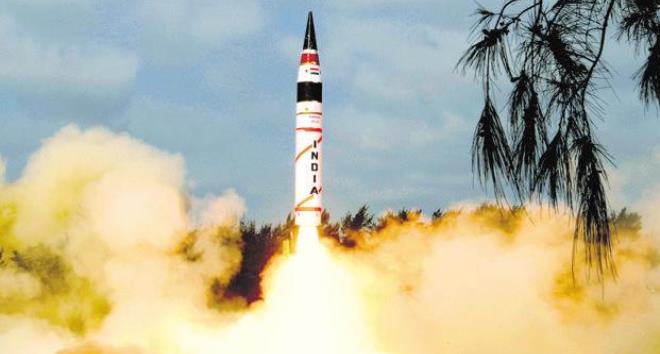Balasore: India on Sunday successfully test-fired nuclear-capable long range ballistic missile Agni-5 which has a strike range of 5000 km off the Odisha coast.
The surface-to-surface missile was launched with the help of a mobile launcher from launch pad-4 of the Integrated Test Range (ITR) in the Bay of Bengal at 9.48 am. This was the sixth trial of the state-of-the-art missile which covered its full distance during the trial.
“The flight performance of the missile was tracked and monitored by radars, tracking instruments and observation stations all through the mission,” said a Defence Research and Development Organisation(DRDO) official. Agni-5 is considered as the most advanced technologies in terms of navigation and guidance, warhead and engine.
The missile has been programmed in such a way that after reaching the peak of its trajectory, it will turn towards the earth and continue its journey towards the intended target with an increased speed due to the attraction of earth’s gravitational pull. The path has been precisely directed by the advanced on-board computer and inertial navigation system.
As the missile enters the earth’s atmosphere, the atmospheric air rubbing the skin of the missile during the re-entry phase raises the temperature beyond 4,000 degrees Celsius, the DRDO official said.
However, the indigenously designed and developed carbon-carbon composite heat shield continues to burn sacrificially, protecting the payload and maintaining the inside temperature below 50 degrees Celsius, the sources added.
Finally, commanded by the on-board computer with a support of ring laser gyro based inertial navigation system, the micro inertial navigation system, fully digital control system and advanced compact avionics, the missile hit the designated target point accurately, meeting all mission objectives, the official said.
The ships located in mid-range and at the target point, tracked the vehicle and witnessed the final event. All the radars and electro-optical systems along the path monitored all parameters of the missile and displayed in real time, he added.
The first two flights of Agni-5 in 2012 and 2013 respectively, were in open configuration. The third, fourth and fifth launches were from canister integrated with a mobile launcher, in its deliverable configuration that enables launch of the missile with a very short preparation time as compared to an open launch.





